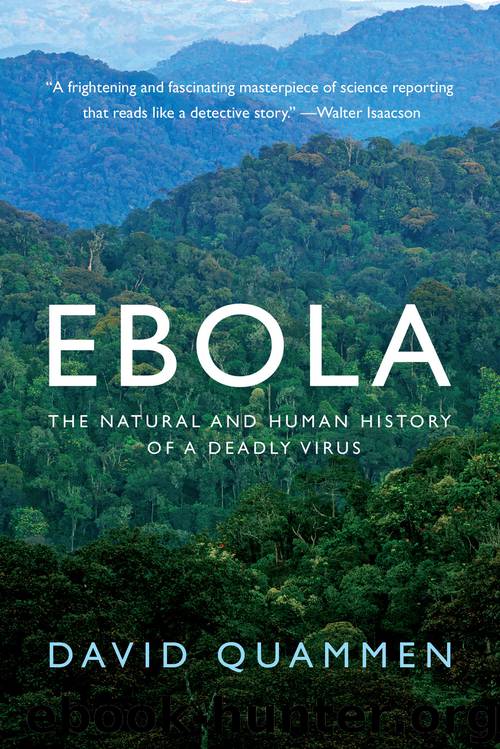Ebola by David Quammen

Author:David Quammen
Language: eng
Format: epub
ISBN: 9780393351569
Publisher: W. W. Norton & Company
12
THINK OF A BSL-4 laboratory—not necessarily AA-5 at USAMRIID but any among a handful around the world in which this virus is studied. Think of the proximity, the orderliness, and the certitude. Ebola virus is in these mice, replicating, flooding their bloodstreams. Ebola virus is in that tube, frozen solid. Ebola virus is in the Petri dish, forming plaques among human cells. Ebola virus is in the syringe; beware its needle. Now think of a forest in northeastern Gabon, just west of the upper Ivindo River. Ebola virus is everywhere and nowhere. Ebola virus is present but unaccounted for. Ebola virus is near, probably, but no one can tell you which insect or mammal or bird or plant is its secret repository. Ebola virus is not in your habitat. You are in its.
That’s how Mike Fay and I felt as we hiked through the Minkébé forest in July 2000. Six days after my helicopter fly-in we left the inselbergs area, trudging southwest on Fay’s compass line through a jungle of great trees, thorny vines interwoven into torturous thickets, small streams and ponds, low ridges between the stream drainages, mud-bordered swamps dense with thorny vegetation, fallen fruits as big as bocce balls, driver ants crossing our path, groups of monkeys overhead, forest elephants in abundance, leopards, almost no signs of human visitation, and roughly a trillion cheeping frogs. The reservoir host of Ebola virus was there too, presumably, but we couldn’t have recognized it as that if we’d looked it in the face. We could only take sensible precautions.
On the eleventh day of walking, one of Fay’s forest crewmen spotted a crested mona monkey on the forest floor, a youngster, alive but near death, with blood dripping from its nostrils. Possibly it had missed its grip in a high tree and suffered a fatal fall. Or … maybe it was infected with something, such as Ebola, and came down to die. Under standing instructions from Fay, the crewman didn’t touch it. Fay’s crew of hardworking Bantus and Pygmies always hungered after wild meat for the evening pot, but he forbade hunting on conservation grounds—and during this stretch through Minkébé he had commanded his cook even more sternly: Do not feed us anything found dead on the ground. That night we ate another brownish stew, concocted from the usual freeze-dried meats and canned sauces, served over instant mashed potatoes. The dying monkey, I fervently hoped, had been left behind.
One night later, at the campfire after dinner, Fay helped me tease some direct testimony from Sophiano Etouck, the shier of the two survivors from Mayibout 2. I had heard the whole story—including the part about Sophiano’s personal losses—from the voluble Thony M’Both, but Sophiano himself, burly, diffident, had never spoken up. Now finally he did. The sentences were diced cruelly by his stutter, which sometimes brought him to what seemed an impassable halt; but Sophiano pushed on, and between blockages his words came quickly.
He had been traveling to one of the gold camps. Farther upriver.
Download
This site does not store any files on its server. We only index and link to content provided by other sites. Please contact the content providers to delete copyright contents if any and email us, we'll remove relevant links or contents immediately.
When Breath Becomes Air by Paul Kalanithi(7276)
Why We Sleep: Unlocking the Power of Sleep and Dreams by Matthew Walker(5664)
Paper Towns by Green John(4179)
The Immortal Life of Henrietta Lacks by Rebecca Skloot(3834)
The Sports Rules Book by Human Kinetics(3597)
Dynamic Alignment Through Imagery by Eric Franklin(3503)
ACSM's Complete Guide to Fitness & Health by ACSM(3475)
Kaplan MCAT Organic Chemistry Review: Created for MCAT 2015 (Kaplan Test Prep) by Kaplan(3430)
Introduction to Kinesiology by Shirl J. Hoffman(3307)
Livewired by David Eagleman(3137)
The River of Consciousness by Oliver Sacks(2999)
Alchemy and Alchemists by C. J. S. Thompson(2918)
The Death of the Heart by Elizabeth Bowen(2910)
Descartes' Error by Antonio Damasio(2746)
Bad Pharma by Ben Goldacre(2737)
The Gene: An Intimate History by Siddhartha Mukherjee(2502)
Kaplan MCAT Behavioral Sciences Review: Created for MCAT 2015 (Kaplan Test Prep) by Kaplan(2495)
The Fate of Rome: Climate, Disease, and the End of an Empire (The Princeton History of the Ancient World) by Kyle Harper(2444)
The Emperor of All Maladies: A Biography of Cancer by Siddhartha Mukherjee(2440)
